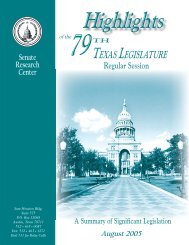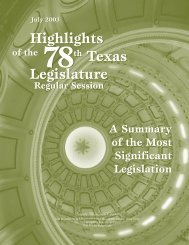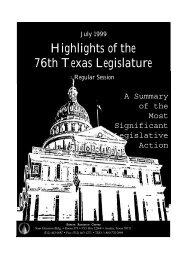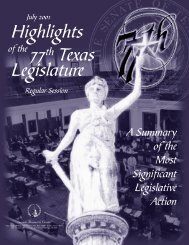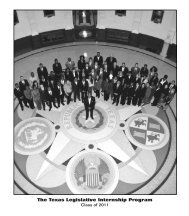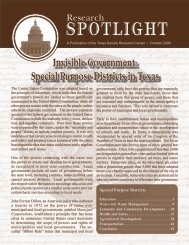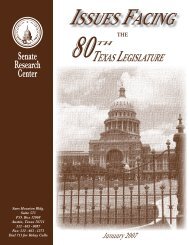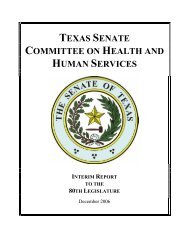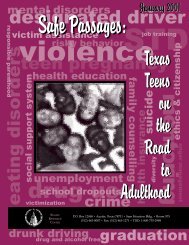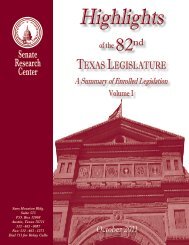Andrea Hodge, Executive Director, Rice Education ... - Senate
Andrea Hodge, Executive Director, Rice Education ... - Senate
Andrea Hodge, Executive Director, Rice Education ... - Senate
You also want an ePaper? Increase the reach of your titles
YUMPU automatically turns print PDFs into web optimized ePapers that Google loves.
3<br />
Melanie Singleton, ReeP CohoRt i – MBa<br />
These problems are particularly acute in urban schools. The New<br />
Teacher Project has reported “there is a shortage of high-quality<br />
principal candidates available to urban schools,” explaining that,<br />
“Urban districts suffer from…relatively low quality candidates<br />
in general and a heavy reliance on internal candidates.” 7<br />
a pREmium on<br />
convEntional Wisdom<br />
<strong>Education</strong>al leaders, at all levels, are handicapped by limited<br />
exposure to organizations outside K-12. For instance, The<br />
American Association of School Administrators has reported<br />
that the traditional career path for superintendents “involves<br />
moving through organizational hierarchy of a public school<br />
district…most superintendents have entered the education<br />
profession as teachers and then became building-level<br />
administrators.” Indeed, 80 percent of superintendents follow a<br />
career path that leads from teacher to principal to superintendent<br />
(with two-thirds serving in the district central office en route). 10<br />
Principals are drawn almost entirely from the ranks of former<br />
teachers, and almost all receive their leadership training in schools<br />
of education. 11 More than 99 percent of superintendents have<br />
been teachers, with two-thirds starting out in K-8. 12 Two-thirds<br />
taught for at least six years and half of all superintendents obtained<br />
their first administrative position before age 30. 13<br />
reep.rice.edu<br />
Few leaders have had much experience working outside the<br />
confines of K-12 education – and they express little desire to do<br />
so. 14 On one hand, it’s good that our school systems are led by<br />
committed veteran educators, but this also means that most<br />
leaders have never had much opportunity to see how budgeting,<br />
accountability, personnel evaluation or compensation are tackled<br />
outside of K-12. Meanwhile, although educational leadership lies<br />
at the intersection of two vibrant and powerful bodies of thought—<br />
education and leadership—it tends to be the province of a narrow<br />
population of “education administration” specialists.<br />
A consequence of their socialization and preparation is that most<br />
principals and superintendents inhabit a culture that puts a<br />
premium on business-as-usual solutions. Although managers in<br />
most organizations take for granted the utility of rewarding<br />
effective employees and sanctioning ineffective ones, such views<br />
are atypical in schooling. Public Agenda reported in 2006 that<br />
only one in five superintendents, and even fewer school leaders,<br />
thought linking consequences to student learning could be a<br />
“very effective” way to improve teacher quality. Just 11 percent<br />
of superintendents said “putting more business practices into<br />
how school systems are run” would be a “very effective” strategy<br />
for improving school leadership. 15 Meanwhile, a majority of<br />
principals believed that teacher quality could be boosted “very<br />
effectively” by increasing professional development or decreasing<br />
class size. In short, there is deep skepticism of measures that<br />
borrow on leadership approaches from beyond K-12.<br />
<strong>Education</strong> leaders sense the problem. In 2006, 61 percent of<br />
superintendents and 66 percent of principals agreed that “typical<br />
leadership programs in graduate schools of education are out of<br />
touch with the realities of what it takes to run today’s school<br />
district.” 16 Principal preparation programs devote little or no<br />
attention to such issues as removing mediocre employees or using<br />
data to overhaul operations. Courses emphasized complying with<br />
legal and financial regulations while giving short shrift to how<br />
leaders might utilize data or technology. 17<br />
And the education leadership canon consists almost entirely of<br />
authors who focused on the “unique” challenges of school<br />
leadership. The most commonly assigned authors included such<br />
school leadership icons as Tom Sergiovanni, Michael Fullan, Lee<br />
Bolman and Linda Darling-Hammond. Absent were such<br />
influential management thinkers as Michael Porter, Jim Collins,<br />
Clayton Christensen and Tom Peters. As a result, leaders who<br />
have spent their entire careers in K-12 education may have had<br />
little exposure to different ways of thinking and may learn to<br />
regard familiar routines as inevitable and immutable. 18



